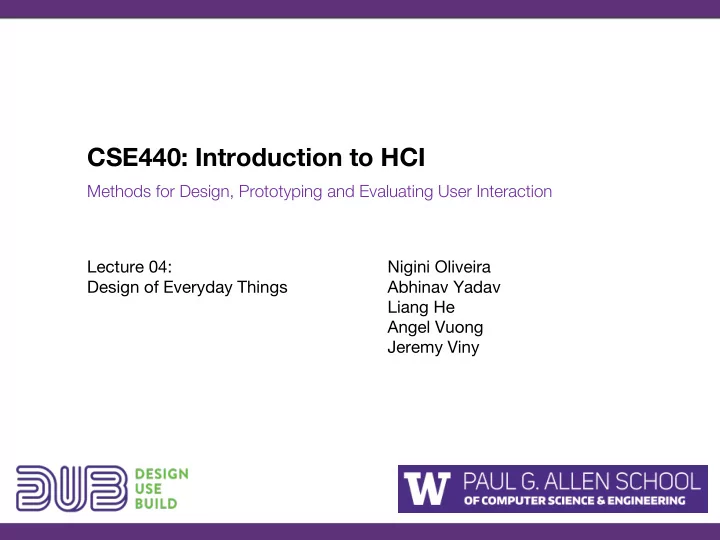

CSE440: Introduction to HCI Methods for Design, Prototyping and Evaluating User Interaction Lecture 04: Nigini Oliveira Design of Everyday Things Abhinav Yadav Liang He Angel Vuong Jeremy Viny
What we will do today It is never a user’s fault!
99% Invisible Post. (Just read and listen everything there!) =)
What is Interaction? Two-Way One-way is reaction Communicative Information is sent Receptive Information is received Effective There are changes as a result
What is Interaction? Two-Way One-way is reaction Communicative Information is sent Receptive Information is received Effective There are changes as a result
Buxton’s 3-State Model
Buxton’s 3-State Model
Buxton’s 3-State Model
Norman’s Execution-Evaluation Cycle
Norman’s Execution-Evaluation Cycle
Norman’s Execution-Evaluation Cycle Gulf of Execution
Norman’s Execution-Evaluation Cycle Gulf of Evaluation
Norman’s Execution-Evaluation Cycle Gulf of Evaluation Gulf of Execution
Norman’s Execution-Evaluation Cycle Gulf of Evaluation Gulf of Execution What factors can extend the Gulfs in the example of increasing light in the room?
Gulf of Evaluation: An Example
Gulf of Evaluation: An Example
Bridging the Gulfs Ask yourself: How easily can the user…
Bridging the Gulfs Ask yourself: How easily can the user… …determine what the system is for?
Bridging the Gulfs Ask yourself: How easily can the user… …determine what the system is for? …tell what actions are possible?
Bridging the Gulfs Ask yourself: How easily can the user… …determine what the system is for? …tell what actions are possible? …identify and carry out the appropriate action?
Bridging the Gulfs Ask yourself: How easily can the user… …perceive and interpret what happened? …determine what the system is for? …tell what actions are possible? …identify and carry out the appropriate action?
Bridging the Gulfs Ask yourself: How easily can the user… …evaluate progress towards the goal? …perceive and interpret what happened? …determine what the system is for? …tell what actions are possible? …identify and carry out the appropriate action?
Let's Bridge the Gulfs... … of finding the right Screenshot in my computer!
Design principles help us answer these questions Affordances Constraints Feedback Consistency Metaphors Mappings Visibility
Design principles help us answer these questions Affordances Constraints Feedback Consistency Metaphors Mappings Visibility
Affordances
Affordances
Affordances “In general, when the apparent affordances of an artifact matches its intended use, the artifact is easy to operate. When apparent affordances suggest different actions than those for which the object is designed, errors are common.” Gaver
False affordances
False affordances
Hidden affordances When there is no perceptual information suggesting an actual intended use
Hidden affordances Logos linking to home is a convention, but not afforded by the page
Clarification on Convention “Designers sometimes will say that when they put an icon, cursor, or other target on the screen, they have added an ‘affordance’ to the system. This is a misuse of the concept. … It is wrong to claim that the design of a graphical object on the screen ‘affords clicking.’ … Yes, the object provides a target and it helps the user know where to click and maybe even what to expect in return, but those aren’t affordances, those are conventions, and feedback, and the like. … Don’t confuse affordances with conventions.” Norman
Affordances vs Signifiers Affordances are the possible interactions between people and the environment . (It is not a property of the "thing"!) Perceived affordances often act as signifiers, but they can be ambiguous. Signifiers signal things, in particular what actions are possible and how they should be done. Signifiers must be perceivable, else they fail to function. Norman
Design principles Affordances Constraints Feedback Consistency Metaphors Mappings Visibility
Constraints
Constraints
Design principles Affordances Constraints Feedback Consistency Metaphors Mappings Visibility
Feedback https://www.videoblocks.com/video/loading-bar-scribble-animation-doodle-cartoon-4k-b03byrauliz20iitl
Feedback All actions have to be confirmed Must be immediate Must be informative Preferably non-distracting and unobtrusive
Feedback ? https://www.videoblocks.com/video/loading-bar-scribble-animation-doodle-cartoon-4k-b03byrauliz20iitl
Design principles Affordances Constraints Feedback Consistency Metaphors Mappings Visibility
Consistency Interfaces should be consistent in meaningful ways Ubiquitous use of same keys for cut/copy/ paste Types of consistency Internal (i.e., within itself) e.g., same terminology and layout throughout External (i.e., with other applications) e.g., common widget appearance e.g., design patterns common across applications
Is consistency always better?
Design principles Affordances Constraints Feedback Consistency Metaphors Mappings Visibility
Metaphors … …
Example: Mail Metaphor
Example: Health Metaphor
Broken Metaphors Are not consistent, do not operate in every circumstance, or do not uphold things consistent with what the metaphor would suggest
Dead Metaphors Lost the original imagery of their meaning
Design principles Affordances Constraints Feedback Consistency Metaphors Mappings Visibility
Mappings
Mappings
Mappings
Mappings
Mappings
Design principles Affordances Constraints Feedback Consistency Metaphors Mappings Visibility
Visibility
Visibility
Visibility Differentiate opposing functionality Use visual function to confirm the user's mental model of operation Sometimes sound can be used to make things ‘visible’ (e.g. vacuum cleaner clogging up) Just the right things have to be visible: excess is as bad as lack of visible clues
Activity: Bad Design Hunt Can you discover instances of bad design on campus? False affordances? A lack of consistency, visibility, or mappings? “Thanks to you, I now constantly notice how badly things are designed.” — anonymous student
Ask me something!
Recommend
More recommend